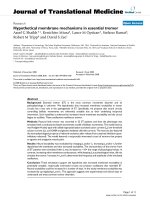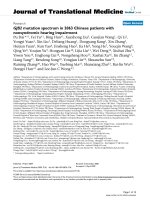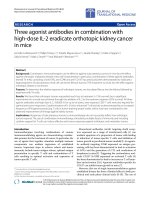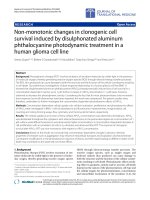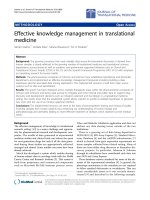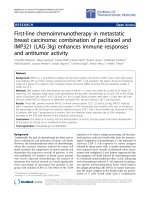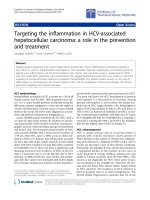báo cáo hóa học:" Flexible intramedullary nailing in paediatric femoral fractures. A report of 73 cases" pptx
Bạn đang xem bản rút gọn của tài liệu. Xem và tải ngay bản đầy đủ của tài liệu tại đây (2.31 MB, 31 trang )
This Provisional PDF corresponds to the article as it appeared upon acceptance. Fully formatted
PDF and full text (HTML) versions will be made available soon.
Flexible intramedullary nailing in paediatric femoral fractures. A report of 73
cases
Journal of Orthopaedic Surgery and Research 2011, 6:64 doi:10.1186/1749-799X-6-64
Ramprakash Lohiya ()
Vikas Bachhal ()
Usman Khan ()
Deepak Kumar ()
Vishwapriya Vijayvargiya ()
Sohan S Sankhala ()
Rakesh Bhargava ()
Nipun Jindal ()
ISSN 1749-799X
Article type Research article
Submission date 29 May 2011
Acceptance date 22 December 2011
Publication date 22 December 2011
Article URL />This peer-reviewed article was published immediately upon acceptance. It can be downloaded,
printed and distributed freely for any purposes (see copyright notice below).
Articles in Journal of Orthopaedic Surgery and Research are listed in PubMed and archived at
PubMed Central.
For information about publishing your research in Journal of Orthopaedic Surgery and Research or
any BioMed Central journal, go to
/>For information about other BioMed Central publications go to
/>Journal of Orthopaedic Surgery
and Research
© 2011 Lohiya et al. ; licensee BioMed Central Ltd.
This is an open access article distributed under the terms of the Creative Commons Attribution License ( />which permits unrestricted use, distribution, and reproduction in any medium, provided the original work is properly cited.
Flexible intramedullary nailing in paediatric femoral fractures. A report of 73 cases
Ramprakash Lohiya
*
, Vikas Bachhal
¶
, Usman Khan
¥
, Deepak Kumar
¥
, Vishwapriya
Vijayvargiya
¥
, Sohan S Sankhala
¥
and Rakesh Bhargava
¥
*
Department of Orthopaedics, All India Institute of Medical Sciences, New Delhi 110029,
India
¶
Registrar, Department of Orthopaedics, Postgraduate Institute of Medical Education and
Research, Chandigarh 160012, India
¥
Sawai Man Singh Medical College and Hospital, Sawairam Singh Road, Jaipur 302004,
Rajasthan, India
Email addresses:
RL:
VB:
UK:
DK:
VPV:
SSS:
RB:
Corresponding Author: Dr Vikas Bachhal
Registrar, Department of Orthopaedics, Postgraduate Institute of Medical Education and
Research, Chandigarh 160012, India.
Email:
Phone: +91 9914209098, +91 172 2640345
Abstract
Background: Flexible intramedullary nailing has emerged as an accepted procedure for
paediatric femoral fractures. Present indications include all patients with femoral shaft
fractures and open physis. Despite its excellent reported results, orthopaedic surgeons
remain divided in opinion regarding its usefulness and the best material used for nails. We
thus undertook a retrospective study of paediatric femoral fractures treated with titanium
or stainless steel flexible nails at our institute with a minimum of 5 years follow up.
Material and Methods: We included 73 femoral shaft fractures in 69 patients treated with
retrograde flexible intramedullary nailing with a minimum follow up of 5 years. Final limb
length discrepancy and any angular or rotational deformities were determined.
Results: Mean age at final follow up was 15.5 years (10-21 years). Mean follow up was 7.16
years (5.0-8.6 years). Titanium and stainless steel nails were used in 43 and 30 cases
respectively. There were 51 midshaft, 17 proximal, and 5 distal fractures.
All fractures united at an average of 11 weeks but asymptomatic malalignment and LLD
were seen in 19% and 58% fractures respectively. LLD ranged from -3 cm to 1.5 cm. Other
complications included superficial infection(2), proximal migration of nail(3), irritation at nail
insertion site(5) and penetration of femoral neck with nail tip(1). There were 59 excellent,
10 satisfactory and 4 poor results.
Conclusion: Flexible intramedullary nailing is reliable and safe for treating paediatric femoral
shaft fractures. It is relatively free of serious complications despite asymptomatic
malalignment and LLD in significant percentage of fractures.
Introduction
After acute infections, trauma is a leading cause of morbidity and mortality in children [1,2].
Although accounting for less than 2% of all orthopaedic injuries in children [3], femoral
fractures have a significant impact not only on the patient and their family network, but also
on regional trauma resources [4,5]. These fractures have been managed with wide variety of
methods in past. Historically treatment with closed means in plaster spica cast, either
immediately or after a period of traction, has yielded acceptable results for these fractures
[6,7,8] but this treatment produces undue physical and psychological stress for patient and
family [9,10,11]. Furthermore, in certain complex fractures and sometimes in subtrochantric
fractures, with tendency for marked flexion of proximal fragment, closed reduction and its
maintenance if often unsuccessful. Last few decades has seen increasing trend towards
operative management of femoral shaft fractures in paediatric patients but opinion
regarding optimal method of fixation of these fractures remains divided [12]. External
fixation, although producing acceptable results, is fraught with many complications as is
plate osteosynthesis and rigid intramedullar nailing which may also require a second major
surgery for removal of implant [13,14,15,16,17,18,19,20,21]. Flexible intramedullary nailing
introduced for femoral fractures by Nancy group in 1982 [22], has become popular with
many orthopaedic surgeons and remains the treatment of choice for these fractures at our
institute due to its favourable results and lack of serious complications.
We undertook a long term retrospective study of paediatric femoral fractures treated with
flexible intramedullary nailing at our institute.
Materials and methods
On retrospective search of hospital records, we found 81 patients of femoral shaft fractures
treated with flexible intramedullary nailing at our institute with a minimum follow up period
of 5 years. All patients with open fractures, pathological fractures, metabolic bone disease
or neuromuscular disorders were excluded from search. Of these 81 patients, 69 patients
with 73 femoral shaft fractures were available for follow up. Indication for surgery in all
cases was displaced femoral shaft fracture with open femoral physis. A written informed
consent was obtained from each patient or their family for inclusion in this study. There
were 53 males (57 fractures) and 16 females (16 fractures) in this series with an average age
of 8.3 (range 4-15) years at the time of injury (Table 1). Fracture locations were 51 midshaft,
17 proximal, and 5 distal fractures. Fracture patterns included transverse (49), oblique (21),
and communited (3) fractures. Fractures were classified according to system of Winquist
[23] as Grade I (45), Grade II (14), Grade III (11) and Grade IV (3) (Table 2). All cases were
operated within first 6 (mean 2.3) days of injury.
All surgeries were performed on fracture table under radiographic control. Two prebent
flexible nails were inserted across the fracture in a retrograde fashion. Although, fracture
reduction was attempted with closed means in all cases but open reduction had to be done
in 12 cases. Both nails were inserted about 2 cm proximal to distal femoral physis from
medial and lateral sides. Medial nail was directed till it was within 2 cm of proximal femoral
capital physis whereas lateral nail was inserted till it was about 1 cm from greater
trochantric physis. Nail diameter was predetermined as being able to fill 40% of medullary
canal at the level of isthimus but in practice intraoperative decision regarding nail diameter
was taken by operating surgeon. Titanium elastic nails were used in 43 fractures while
stainless steel nails in 30 fractures. All titanium nails were bent at insertion site and cut
close to bone leaving 1.5-2 cm of nail protruding for later easy removal. Stainless steel nails
(Ender’s nails) had an eye at distal end which was used for extraction and thus allowed us to
advance it relatively flush with bone. After completion of procedure, rotational stability was
assessed in all cases by rotating distal fragment under radiographic control. Average
operative time for this procedure was 37 (range 25-110) minutes. Under usual
circumstances, most patients were discharged within 2-3 days postoperatively after
inspection of surgical site. Average hospital stay for patients was 5.1 (3-9) days.
Although no postoperative immobilisation was routinely used, however 3 cases with
Winquist Grade IV fractures were put in hip spica cast for initial 4 weeks for achieving better
stability at fracture site. The decision regarding use of postoperative immobilisation was
based entirely on discretion of the operating surgeon who was thought to be the best judge
of stability achieved at fracture site after surgery. We routinely checked for stability of
fractures by moving and stressing the fracture under image intensifier and fractures thought
to be unstable were immobilised for 4-8 weeks postoperatively. Five additional cases with
grade III communition were immobilised with spica cast or knee immobiliser for 4 weeks.
Three of these 5 fractures were distal and 2 involved midshaft region. The purpose of post-
operative immobilization was to provide extra stability at fracture site in cases where
flexible nailing was unable to achieve adequate stability as demonstrated by rotating the
distal segment under radiographic control. This method tested for rotational stability. Apart
from these cases, 3 cases with grade IV comminution were deemed to be axial unstable as
well and thus immobilized. Postoperative rehabilitation included hip and knee mobilisation
on first postoperative day followed by partial weight bearing after significant pain and
inflammation has resolved after 3-4 days. Weight bearing was delayed in cases with
significant communition (Winquist Grade II and above) till signs of callus formation were
evident on follow up radiographs. Weight bearing was again delayed for all four bilateral
cases regardless of the level of commuinition at fracture site. Progression of union at
fracture site was monitored on serial radiographs, usually taken at intervals of 4 weeks, and
full weight bearing was allowed once radiographic union was achieved.
Postoperative radiographs were assessed for nail prominence (measured from nail bone
interface to nail tip), and both postoperative and final follow up radiographs were assessed
for coronal or saggital malalignment and any obvious implant related or unrelated
complication (Figure 1 and 2). Rotational malalignment and limb length discrepancy were
assessed clinically at latest follow up (bilateral fractures were excluded from this assessment
for obvious reason of lack of normal comparison). Significant malalignment was defined as
>10° in coronal plane and >15° in saggital plane. We routinely removed the nails after
achieving solid union although 3 patients failed to show up for routine follow up visits in
time for nail removal resulting in proximal migration of nail insertion site with continued
growth from distal femoral physis. All fractures were rated according to the system
described by Flynn as excellent, satisfactory or poor [24].
Results
Mean age of patients after an average follow up of 7.16 (range 5.0-8.6) years was 15.5
(range 10-21) years. During serial radiographic monitoring for fracture union, early callus
was seen on an average of 3.8 (range 2-6) weeks after surgery and full radiographic union
was achieved at 11 (range 6-18) weeks without further intervention. Post-operative
immobilisation was used in 8 fractures. Early weight bearing was allowed in 45 cases with
Winquist Grade I fracture while in remaining fractures it was delayed variably depending on
progression of union at fracture site. Mean time for achieving unassisted full weight bearing
in these 45 cases was 10.5 weeks as compared to 15 weeks for remaining cases. Nail
removal was done in 70 fractures at an average of 11 (5-16) months postoperatively. All
patients regained full range of motion of knee and hip after removal of nails.
Average nail prominence for titanium nails on medial and lateral sides was 17.5 (8-24) mm
and 19.2 (12-27) mm respectively whereas same values for ender’s nails were 9 (4-15) mm
and 12.6 (4-18) mm respectively. There was a significant difference in nail prominence
between ender’s nail and titanium nail (p<0.01).
Angulation measured at final follow up in both coronal and saggital planes revealed
significant malalignment in 3 cases however minor malalignment was observed in 29 cases.
In contrast rotational malalignment was detected in 11 patients (17%) although this was
measured clinically by comparing hip rotations to opposite normal limb in cases with
unilateral fractures (n=65). There was a significant relation between angular malalignment
with severity of communition as 11 out of 14 patients (71.5%) with winquist grade III or IV
fractures had malalignment as compared to 21 out of 59 in grade I or II (chi square, p<0.01).
We did not find any statistically significant difference in malalignment along any axis
between types of nails (p=0.30). We further did not find any significant relation between
location of fracture and degree of malalignment (p=0.361), however the method of
treatment differed amongst these groups as postoperative spica was used more frequently
for subtrochantric and distal femoral fractures (p<0.01).
Limb length discrepancy, measured clinically in unilateral cases (n=65), ranged from -3 to 1.5
cm and revealed unequal limb lengths in 38 patients (58%) with lengthening in 32 patients
and shortening in 6 patients. However, 25 of these 38 patients had LLD of less than 1 cm and
there were no functional problems reported due to this inequality in length. Of the
remaining 13 patients 5 had shortening and 8 had lengthening of fractured limb. All cases of
shortening occurred in Winquist grade III or IV. There was no statistically significant
difference in limb length discrepancy between the nail types (p=0.21).
Other complications (Table 3) included two cases of superficial infection treated with a
prolonged course of antibiotics and 3 cases with proximal migration of nail insertion site
following continued distal femoral growth due to failure to remove nails in time although no
long term complication occurred in these cases (Figure 3). There was no case of physeal
damage. One of the most frequent complaints of patients was irritation at nail insertion site
due to prominence of nail leading to bursitis in 5 patients (Figure 4) which resolved after
removal of nails but these complaints were significantly more frequent for titanium nails as
compared to ender’s nail (p<0.01). In one case, tip of medial nail was found to have
penetrated the cortex posteriorly but this was discovered at 5
th
postoperative week when
fracture already demonstrated bridging callus (Figure 5 and 6) and this nail was retained till
full union and later removed at 22 postoperative weeks. Proper imaging under C arm with
images in different degree of rotation can avoid this complication as even perfectly aligned
good quality postoperative radiographs might not be able to reveal all such cases. There was
no case of long term knee or hip stiffness although 55.8% cases had some degree of
restriction of knee movements before removal of nails which was done at an average of 11
months postoperatively. According to the criterion of Flynn et al there were 59 excellent, 10
satisfactory and 4 poor results. There was no difference in results with type of nail used in
this series (p=0.12) (Table 4).
Discussion
Paediatric femoral shaft fractures had been traditionally treated with non operative
methods with traction and spica cast application [6,7,8], however over the past two decades
operative treatment has been increasingly tried in order to avoid prolonged immobilisation
and other complications of earlier methods. Most popular of these operative treatments
have been internal fixation with plate [25,26,27], rigid fixation with intramedullary nail [28],
external fixation [29,30] and more recently flexible intramedullary nailing [24]. Each of these
methods has its advantages and disadvantages. External fixation has been associated with
refracture and pin-tract infection [31], solid intramedullary nailing with avascular necrosis of
the femoral head [18,31,32], thinning of the femoral neck [21] and growth arrest of the
greater trochanter with secondary coxa valga [17,21]. In addition, plating of the femur
demands extensive soft-tissue dissection and has been related with hardware failure,
infection and greater blood loss [31]. Flexible intramedullary nailing, by allowing
micromotion at fracture site, promotes bone healing without violating open physis and,
being a closed procedure, has a low risk of infection.
Flexible nails had been used for fixation of peritrochanteric fractures with some success
[33,34] but its application for paediatric shaft fractures was popularised by nancy team [22].
Since then several authors have reported on the results and complications of this technique.
The earlier indication of this technique for femoral shaft fractures was in patients of 6-16
years age group but several authors have reported excellent results in preschool children
too [35,36]. Perhaps operative indications for femoral shaft fractures can be expanded to
include children of all ages with femoral shaft fractures and open physis.
Flexible nailing for paediatric femoral shaft fractures has yielded predictably excellent union
across the literature. Ligier et al reported union in all 123 cases treated with this technique
[22]. Flynn et al [24] (n=58) and Narayanan et al [12] (n=79) also did not report any union
difficulties. Luhmann et al [37] observed one hypertrophic non union in 43 treated femoral
shaft fractures. Postoperative immobilisation has been variably used after internal fixation
with flexible nails. Ligier et al [22] did not use any postoperative immobilisation in contrast
to selective use of spica cast or knee immobilisers by Flynn et al [24] (41/58), Luhmann et al
[37] (17/38), Moroz et al [38] (201/234). We used postoperative immobilisation in 8 patients
only since adequate fracture stability was achieved in all other cases. Degree of
communition was a clear predictor of use of postoperative immobilisation in this series as
all such cases were either winquist grade III or IV.
Although most authors have recommended routine nail removal after union however few
have recently questioned this practice. Morshed et al in a retrospective study involving 25
fractures treated with TENS reported survivorship free of revision due to pain of 72% at 5
years follow up [39]. Timing of nail removal after fracture union has not been uniform
amongst previously published series and there are no clear guidelines in literature. Although
early removal has led to occasional complication [24], however many authors have reported
satisfactory outcome even after removal of nails as early as beginning of third postoperative
month [22]. Overall, most authors have typically recommended nail removal after fracture
healing at 6 months to 1 year following surgery [39]. We didn’t encounter any difficulty in
nail removal even after 1 year and routinely advised our patients for this procedure. Three
cases refused for nail removal and demonstrated proximal migration of nail insertion site
due to continued growth from distal femoral physis although it did not result in any long
term complication.
It has been recommended that diameter of each nail should measure 40% of narrowest
diameter of the medullary canal [24] and both nails should be of same diameter [12]. This
recommendation was followed in all our cases although it was not always possible to follow
40% rule. Use of stainless steel nails has not been recommended in past because of fear of
malunion owing to more stiffness of steel compared to titanium. This view has been refuted
by Wall et al [40] who reported higher malunion rates for titanium nails as compared to
similarly designed stainless steel nails. In our study we did not find any statistically
significant difference in rates of minor or major malunions between nail types whereas steel
nails were considerably cheaper than their titanium counterparts. However, there was a
significant difference in malunion rates with degree of communition at fracture site.
Narayanan et al [36] and Sink et al [41] reported similar effect of communition on malunion
rates.
A frequent complication in this series was skin irritation and pain at nail insertion site
leading to limited range of knee movement which resolved completely after nail removal.
Similarly high incidence of this minor complication has been observed in previous reports
[12,37]. We observed a significant difference in rate of this complication between TENS and
ender’s nail which was related to tendency of leaving nail flush with femoral cortices in
latter. This was perhaps the result of less apprehension of difficulty in nail retrieval in
ender’s nail, which has an eye (hole) at its end for extraction, as compared to TENS and was
not a result of material properties of nails. Narayanan et al [12] has recommended cutting
the ends short and advancing the nails with a hollow tamp until the ends lay adjacent to the
supracondylar flare of the distal femoral metaphysic but this is not universally practiced
technique [24,37]. Moreover, in their series, Narayanan et al [12] did not remove majority of
nails which were cut flush with cortex and their opinion regarding ease of nail removal with
current instrumentation cannot be validated. Recent introduction of end caps for nails may
provide a solution for this problem but our experience with this is not sufficient to make
valid observation [42].
Limb length discrepancy was a frequent but clinically insignificant complication as most
fractured limbs were within 1cm in length of the contralateral normal limb. However,
shortening of >1 cm was observed in 5 patients having grade III or IV communition.
Although lesser degree of limb length discrepancy is fairly common, however most
published articles have reported infrequent occurrence of clinically significant discrepancy
[12,24].
Vrsansky et al [43] reported universally good results in 141 fractures without a single
complication whereas Flynn et al [24] had only one poor result in 58 fractures. Several other
authors have reported variable rates of complications. Sink et al [41] reported 62%
complication rate necessitating unplanned surgery before fracture union in third (21%) of
these cases. The complications in this series were related to length unstable fractures which
were either comminuted or long oblique. In long oblique fractures the length of the
obliquity was twice as long as the diameter of the femur at the level of the fracture.
Comminuted fractures had more than one continuous fracture and a butterfly fragment.
Luhmann et al [37] reported an overall complication rate of 49% (21/43) but only 2 major
postoperative complications with rest being minor complications. Ho et al [44] reported a
total complication rate of 17%. We had fair share of complications with overall 32 patients
reporting significant complication amounting to 44% complication rate. However despite
this high rate of complications, there were only 4 poor results in this series with remaining
patients having only minor complications.
We conclude that flexible nailing for fracture shaft femur in paediatric age group yields
excellent or satisfactory results in majority of patients with reasonable complication rates.
Furthermore, stainless steel nails produce results similar to titanium nails at considerably
less price.
Consent statement
Written informed consent was obtained from each patient for publication of this report and
accompanying images. Copies of written consents are available for review by the Editor-in-
Chief of this journal.
Competing interests
The authors declare that they have no competing interests.
Authors' Contributions
RL and VB reviewed the literature and wrote the paper. UK, SSS and RB were main operating
surgeons in the whole series and critically reviewed the paper. RL, VB, VPV and DK
maintained all the records of the patients and followed them. All the authors read and
approved the final manuscript.
References
1. Steel N, Reading R. Epidemiology of childhood mortality. Current Paediatrics 2002;
12(2): 151-56.
2. Cox PJA, Clarke NMP. Improving the outcome of paediatric orthopaedic trauma: an
audit of inpatient management in Southampton. Ann R Coll Surg Engl 1997; 79: 441-
6.
3. McCartney D, Hinton A, Heinrich SD. Operative stabilization of pediatric femur
fractures. Orthop Clin North Am 1994; 25(4): 635-50.
4. Nafei A, Teichert G, Mikkelson SS, Hvid I. Femoral shaft fractures in children: an
epidemiological study in a Danish urbanpopulation, 1977-86.JPediatrOrthop 1992;
12(4): 499-502.
5. Henderson J, Goldacre MJ, Fairweather JM, Marcovitch H. Conditions accounting for
substantial time spent in hospital in children aged 1-14 years. Arch Dis Child 1992;
67(1): 83-6.
6. Irani RN, Nicholson JT, Chung SM (1976) Long-term results in the treatment of
femoral-shaft fractures in young children by immediate spica immobilization. J Bone
Joint Surg Am 58(7):945–951
7. Sugi M, Cole WG (1987) Early plaster treatment for fractures of the femoral shaft in
childhood. J Bone Joint Surg Br 69(5):743–745
8. Czertak DJ, Hennrikus WL (1999) The treatment of pediatric femur fractures with
early 90–90 spica casting. J Pediatr Orthop 19(2):229–232
9. van Tets W F, van der Werken C. External fixation for diaphyseal femoral fractures: a
benefit to the young child? Injury 1991; 23: 162-4.
10. Hughes B F, Sponseller P D, Thompson J D. Pediatric femur fractures: Effects of spica
cast treatment on family and community. J Pediatr Orthop 1995; 15: 457-60.
11. Stans A A, Morrissy R T, Renwick S E. Femoral shaft fractures treatment in patients
aged 6 to 16 years. J Pediatr Orthop 1999; 19: 222-38.
12. Narayanan UG, Hyman JE, Wainwright AM, Rang M, Alman BA. Complications of
elastic stable intramedullary nail fixation of pediatric femoral fractures, and how to
avoid them. J Pediatr Orthop. 2004 Jul-Aug;24(4):363-9.
13. Sponseller P D. Surgical management of pediatric femoral fractures. Instr Course Lect
2002; 51: 361-5.
14. Fyodorov I, Sturm P F, Robertsson W W. Compression-plate fixation of femoral shaft
fractures in children aged 8 to 12 years. J Pediatr Orthop 1999; 19: 578-81
15. Mostafa M, Hassan M, Gaballa M. Treatment of femoral shaft fractures in children
and adolescents. J Trauma 2001; 51: 1182-8.
16. Galpin R D, Willis R B, Sabano N. Intramedullary nailing of pediatric Femoral
Fractures. J Pediatr Orthop 1994; 14: 184-9.
17. Raney E M, Ogden J A, Grogan D P. Premature greater trochanteric epiphysiodesis
secondary to intramedullary femoral rodding. J Pediatr Orthop 1993; 13: 516-20.
18. Beaty J H, Austin S M, Warner W C, Canale S T, Nichols L. Interlocking Intramedullary
Nailing of Femoral-Shaft Fractures in Adolescents: Preliminary Results and Com-
plications. J Pediatr Orthop 1994; 14: 178-83.
19. Probe R, Lindsey RW, Hadley NA, et al. Refracture of adolescent femoral shaft
fractures: a complication of external fixation: a report of two cases. J Pediatr Orthop
1993;13:102–5.
20. Beaty JH. Aseptic necrosis of the femoral head following antegrade nailing of femoral
fractures in adolescents. Tech Orthop 1998;13:96–9.
21. Gonzalez-Herranz P, Burgos-Flores J, Rapariz JM, et al. Intramedullary nailing of the
femur in children. J Bone Joint Surg Br 1995; 77:262–6.
22. Ligier JN, Metaizeau JP, Prévot J, Lascombes P. Elastic stable intramedullary nailing of
femoral shaft fractures in children. J Bone Joint Surg Br. 1988 Jan;70(1):74-7
23. Winquist RA, Hansen RT, Clawson DK. Closed intramedullary nailing of femoral
fractures. A report of five hundred and twenty cases. J Bone Joint Surg 66A:529,
1984
24. Flynn JM, Hresko T, Reynolds RA, Blasier RD, Davidson R, Kasser J. Titanium elastic
nails for pediatric femur fractures: a multicenter study of early results with analysis
of complications. J Pediatr Orthop. 2001 Jan-Feb;21(1):4-8.
25. Kregor PJ, Song KM, Rouff Jr ML, et al. Plate fixation of femoral shaft fractures in
multiply injured children. J Bone Joint Surg 1993;75:1774–80.
26. Ward WT, Levy J, Kaye A. Compression plating for child and adolescent femur
fractures. J Pediatr Orthop 1992;12:626–32.
27. van Riet Y E A, van der Werken C, Marti R K. Subfascial plate fixation of comminuted
diaphyseal femoral fractures: A report of three cases utilizing biological
Osteosynthesis. J Orthop Trauma 1996; 11: 57-60.
28. Buford D, Christensen K, Weatherall P. Intramedullary nailing of femoral fractures in
adolescents. Clin Orthop 1998;350:85–9.
29. Tolo VT. External skeletal fixation in children’s fractures. J Pediatr Orthop
1993;13:435–42.
30. Aronson J, Tursky EA. External fixation of femur fractures in children. J Pediatr
Orthop 1992;12:157–63.
31. Sanders JO, Browne RH, Mooney JF, et al. Treatment of femoral fractures in children
by pediatric orthopedists: results of a 1998 survey. J Pediatr Orthop 2001;21:436–41.
32. O’MaleyDE,Mazur JM, Cummings RJ. Femoral head avascular necrosis associated
with intramedullary nailing in an adolescent. J Pediatr Orthop 1995;15:21–3.
33. Kuderna H, Böhler N, Collon DJ. Treatment of intertrochanteric and subtrochanteric
fractures of the hip by the Ender method. J Bone Joint Surg Am. 1976 Jul;58(5):604-
11.
34. Raugstad TS, Mølster A, Haukeland W, Hestenes O, Olerud S. Treatment of
pertrochanteric and subtrochanteric fractures of the femur by the Ender method.
Clin Orthop Relat Res. 1979 Jan-Feb;(138):231-7.
35. Mortier D, De Ridder K. Flexible intramedullary nailing in the treatment of diaphyseal
fractures of the femur in preschool children. Acta Orthop Belg. 2008 Apr;74(2):190-4.
36. Bopst L, Reinberg O, Lutz N. Femur fracture in preschool children: experience with
flexible intramedullary nailing in 72 children. J Pediatr Orthop. 2007 Apr-
May;27(3):299-303.
37. Luhmann SJ, Schootman M, Schoenecker PL, Dobbs MB, Gordon JE. Complications of
titanium elastic nails for pediatric femoral shaft fractures. J Pediatr Orthop. 2003 Jul-
Aug;23(4):443-7.
38. Moroz LA, Launay F, Kocher MS, Newton PO, Frick SL, Sponseller PD, Flynn JM.
Titanium elastic nailing of fractures of the femur in children. Predictors of
complications and poor outcome. J Bone Joint Surg Br. 2006 Oct;88(10):1361-6.
39. Morshed S, Humphrey M, Corrales LA, Millett M, Hoffinger SA. Retention of flexible
intramedullary nails following treatment of pediatric femur fractures. Arch Orthop
Trauma Surg. 2007 Sep;127(7):509-14.
40. Wall EJ, Jain V, Vora V, Mehlman CT, Crawford AH. Complications of titanium and
stainless steel elastic nail fixation of pediatric femoral fractures. J Bone Joint Surg
Am. 2008 Jun;90(6):1305-13.
41. Sink EL, Gralla J, Repine M. Complications of pediatric femur fractures treated with
titanium elastic nails: a comparison of fracture types. J Pediatr Orthop. 2005 Sep-
Oct;25(5):577-80.
42. Nectoux E, Giacomelli MC, Karger C, Gicquel P, Clavert JM. Use of end caps in elastic
stable intramedullary nailing of femoral and tibial unstable fractures in children:
preliminary results in 11 fractures. J Child Orthop. 2008 Aug;2(4):309-14.
43. Vrsansky P, Bourdelat D, Al Faour A. Flexible intramedullary pinning technique in the
treatment of pediatric fractures. J Pediatr Orthop 2000;20:23–7.
44. Ho CA, Skaggs DL, Tang CW, Kay RM. Use of flexible intramedullary nails in pediatric
femur fractures. J Pediatr Orthop. 2006 Jul-Aug;26(4):497-504.
Figure legends
Figure 1: Radiographs of a 6 year old child with femoral shaft fracture of right side (A)
treated by Ender’s nail. Excellent fracture reduction (B) was maintained till fracture union
(C) and final follow up radiographs at 6 years postoperatively (D) demonstrated neutral
alignment in both anteroposterior and lateral views.
Figure 2: Radiographs of a 9 year old child with left sided femoral shaft fracture managed by
titanium flexible nailing (A) shows significant malalignment in both coronal (15° varus) and
saggital plane (10° anterior apex). Fracture alignment improved slightly during follow up
(B,C) and at 7 years significant malalignment still remained in coronal plane (15°) but not in
saggital plane.
Figure 3: Proximal migration of nail insertion site due to growth from distal femoral physis.
Patient remained asymptomatic.
Figure 4: Superficial skin breakdown at lateral nail insertion site of titanium flexible nail.
Figure 5: Lateral radiographs of a patient showing good nail position in proximal femur on
immediate postoperative radiographs
Figure 6: Lateral radiographs of patient in figure 5 at 5
th
postoperative week revealed
penetration of posteromedial by medial nail. Nail was retained till full union.
Table 1: DEMOGRAPHICS
Patients treated 81
Patients followed 69
Fractures followed 73
Male:Female 53(57 fractures):16(16 fractures)
Mean age 8.3 years(4-15)
Nail used
TENS 43
Enders 30
Table 2: FRACTURE CHARACTERISTICS
Location
Proximal 17
Midshaft 51
Distal 5
Pattern
Transverse
49
Oblique
21
Communited
3
Winquist grading
I 45
II 14
III 11
IV 3
Table 3: COMPLICATIONS
Malunion (coronal/saggital) 3
Limb length disrepency 13
Superficial infection 2
Proximal migration 3
Bursitis at nail insertion site 5
Perforation of cortex of femoral neck 1
Table 4: Results according to nail type
Excellent Satisfactory Poor Total
TENS 37 3 3 43
Ender’s Nail 22 7 1 30
Total 59 10 4 73

